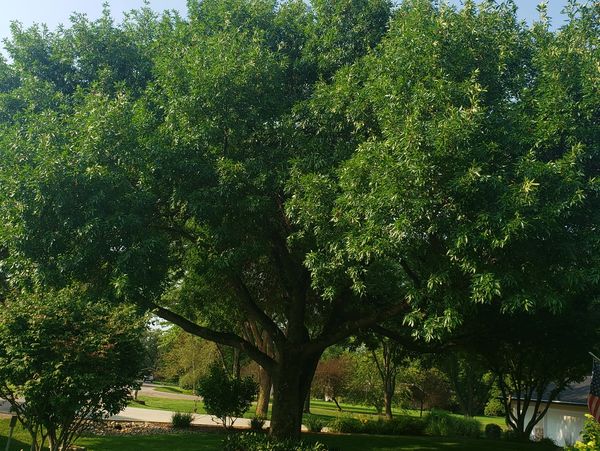Ash trees on the same property. See the difference!
Treated Tree
Untreated Trees
Untreated Trees

Trees that are treated maintain a full canopy and you see minimal signs of infestation. The more damage a tree shows the tougher it will be to treat.
Untreated Trees
Untreated Trees
Untreated Trees

Infested trees start to die back from the upper branches. They start to this and then die. You may also notice suckering or water sprouts around the trunk lower on the tree.
Should you treat your ash tree?
We do not recommend treating all ash trees.
Once you start treating your ash tree you will need to continue treatments for the rest of the life of your tree. That is an added expense you may want to avoid. The cost of the treatments increase as the trees get larger. The ash trees we would recommend treating we be as follows:
- The tree is healthy.
- It is providing a useful benefit to the site. This is generally providing shade that may allow spaces to be utilized more or help to reduce heating costs of buildings.
- It is one or one of only a few mature trees on a site.
If the tree is unhealthy, very small, or is one of many on a site, you may be better off removing and replacing the tree. See a list of potential replacement trees below. Please feel free to reach out to us if you would like to find out what we would recommend.

Replacement Shade Trees

Listed below are some shade trees that could be a suitable replacement for an ash.
‘Marmo’ Maple
65’-70’ H 35’-40’ W
Vigorous grower with great structure. Fall color is a mottled blend of red and green to burgundy, yellow and gold. More adaptable to heavy clay soils.
State Street® Maple
40’-45’ H 30’-35’ W
Good resistance to leaf tatter. Excellent adaptability to stress from heat, drought, salt and pollution. Fall color is a soft golden yellow.
‘October Glory’ Maple
50’-60’ H 40’ W
Intense red fall color. Color lasts longer than many other red maples.
‘Redpointe’ Maple
45’ H 30’ W
Broadly pyramidal form with great red fall color.
‘Legacy’ Maple
50’ H 35’ W
Glossy dark green foliage that resists leaf tatter and drought. Fall color of orange and red.
‘Pacific Sunset’ Maple
30’ H 20’-30’ W
Outstanding glossy green summer foliage. Turns to hints of yellow, orange , and red in the fall. Resistant to Japanese Beetle. Very drought tolerant.
European Hornbeam
30’-40’ H 20’ W
Columnar tree with dense canopy. Makes a great screen. Formal appearance. Tolerant of heat and drought. Yellow fall color.
Northern Catalpa
50’-60’ H 35’-40’ W
Fast growing with few branches at an early age. Blooms with white flowers in early summer. Fruit are long persistent pods. Green/yellow fall color. Very adaptable and tolerant tree.
‘Autumn Gold’ Gingko
40’-60’ H 30’-40’ W
Fruitless variety. Very slow growing. No problems with insect or disease to note. Yellow fall color.
‘Skyline’ Honeylocust
50’-60’ H 35’-40’ W
Thornless variety. Large tree with filtered shade. Great choice for urban conditions. Yellow fall color.
‘Expresso’ Kentucky Coffeetree
50’ H 35’ W
Podless variety. Tree has deeply furrowed bark and stout branches which provide winter appeal. Adaptable to alkaline, salt, and drought conditions. Yellow fall color.
‘Bloodgood London Planetree
50’-80’ H 30’-40’ W
Cream and olive colored exfoliating bark. More resistance to anthracnose. Tolerate adverse soils, pollution, heat, and drought. Yellow fall color.
Swamp White Oak
50’-60’ H 30’-40’ W
Excellent in wet and upland soils. Shows good transplant success. Fall color yellow/brown to red.
Bur Oak
60’-70’ H 30’-40’
Attractive corky bark. Interesting winter appeal. Tolerates a wide variety of soil types and pollution. Fall color is yellow/brown to purple.
Northern Red Oak
75’-90’ H 40’-50’ W
Fastest growing oak and easy to transplant. The foliage is dense and hangs on tree into the winter. Fall color is red to red/brown.
Feel free to contact us for a proposal to install new trees on your site.
Copyright © 2019 Hawcott Lawn Service - All Rights Reserved.
